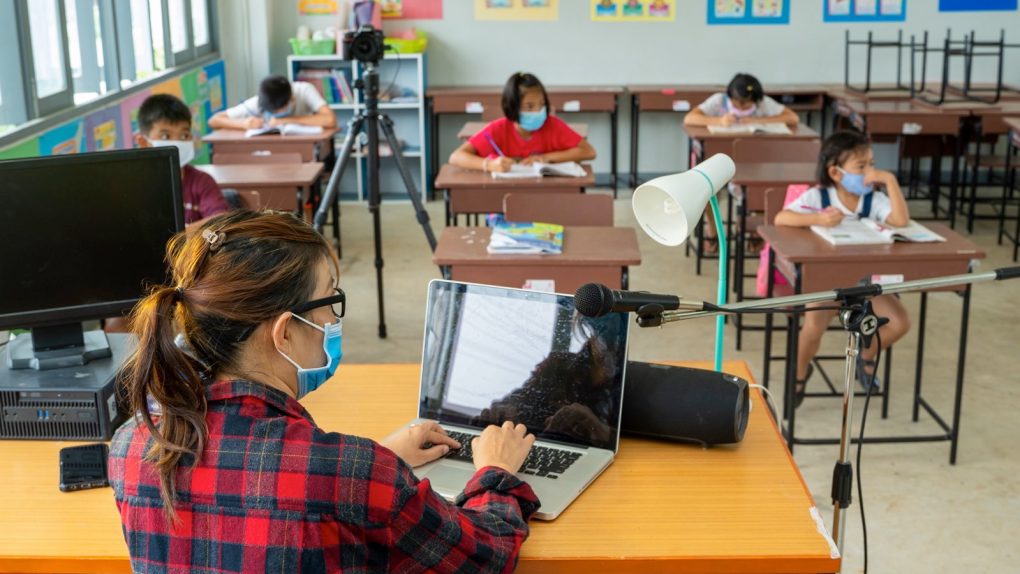- A new study says coronavirus spread might be fueled by infected children, who develop higher viral loads in the upper respiratory tract than adults.
- The study could not measure the actual infectivity of children, but researchers compared COVID-19 with other infectious diseases like the flu, where a higher viral load indicates higher infectivity.
- The new research could help public health officials and schools institute new screening measures to prevent outbreaks that do not include the assessment of symptoms or temperature checks, which are not reliable.
School reopenings during the novel coronavirus pandemic are failing spectacularly in some states, where children and teachers have been infected and thousands upon thousands have been forced to quarantine. Schools in Georgia and Mississippi made the news as examples of how not to bring back students to in-person classes, as thousands of children keep testing positive. Children might not experience severe COVID-19 cases as often as adults, but they can spread the illness to their families and run the risk of developing a severe COVID-related syndrome. A recent study showed that children under the age of five might have up to 100 times more virus in their upper respiratory tracts as adults. The research could not prove whether the kindergarteners were more infectious at the time. Now, a brand new study delivers similar results — it found that children can have higher viral loads than adults, and that can make them more contagious.
A study in the Journal of Pediatrics analyzed data from 192 participants including newborns to 22-year-olds who were classified as children. They were all patients of Massachusetts General Hospital (MGH) Respiratory Infection Control clinics who experienced either COVID-19 symptoms or the multisystem inflammatory syndrome (MIS-C) linked to coronavirus.
Researchers collected throat or nasal swabs and blood samples that were tested for COVID-19. The scientists also compared the levels of the ACE2 receptors the virus binds to from the participants against other children and adults.
Only 49 children tested positive, and only 25 of them experienced a fever. The COVID-positive volunteers showed other symptoms that were not specific to the illness.
“The presence of the virus does not correlate with symptoms,” MGH’s Mucosal Immunology and Biology Research Center director Dr. Alessio Fasano told Newsweek. “In children, the SARS-CoV-2 infection translated mostly into no symptoms or non-specific, mild symptoms that included a runny nose, cough, and or low fever.”
The virus levels were highest in children during the first two days after the onset of symptoms. More interestingly, the viral loads were “significantly higher than hospitalized adults with severe disease,” according to the paper.
Director of the MGH Cystic Fibrosis Center Dr. Lael Yonker told Newsweek that one potential explanation concerns the way the virus behaves. In adults, the virus descends into the lower airways and the lungs. But in children, the infection stays in the upper airways. Children under the age of 10 are less likely to express the ACE2 receptor that the virus uses, which means the coronavirus would not be able to infect them.
Like other studies, this research could not prove conclusively that children are more contagious than adults. But there is a correlation between high viral loads and infectivity in other illnesses. “In other viral infections like influenza, a higher viral load in the secretions indicates increased infectivity,” Yonker said. “In these children, these high SARS-CoV-2 levels in the respiratory tract suggest an increased ability to spread infection.”
The study “proves that they [children] may be equally as contagious as adults and, therefore, they should not be overlooked when public health policies are being developed to fight the pandemic,” Fasano said.
Like other COVID-19 research, the MGH study could benefit from more data, but the researchers made it clear that “no age was ‘protected’ from the virus, and that all ages can carry high levels of the virus.” The study had a limited number of participants because of a short supply of testing kits.
Public health officials and schools should take additional precautions to prevent the spread of COVID-19 as students return to classes. “This study warns that children may play a larger role in the spread of this pandemic if proper precautions are not taken,” Yonker told Newsweek. Monitoring for symptoms like fever will not be enough, and other measures need to be implemented to find infected children, like frequent viral screening. Other measures are also advised, including face masks, frequent hand washing, social distancing, and remote learning.
Fasano warned that a third wave of the pandemic might be fueled by children if “we do not take these new data into account as we reopen schools.”








